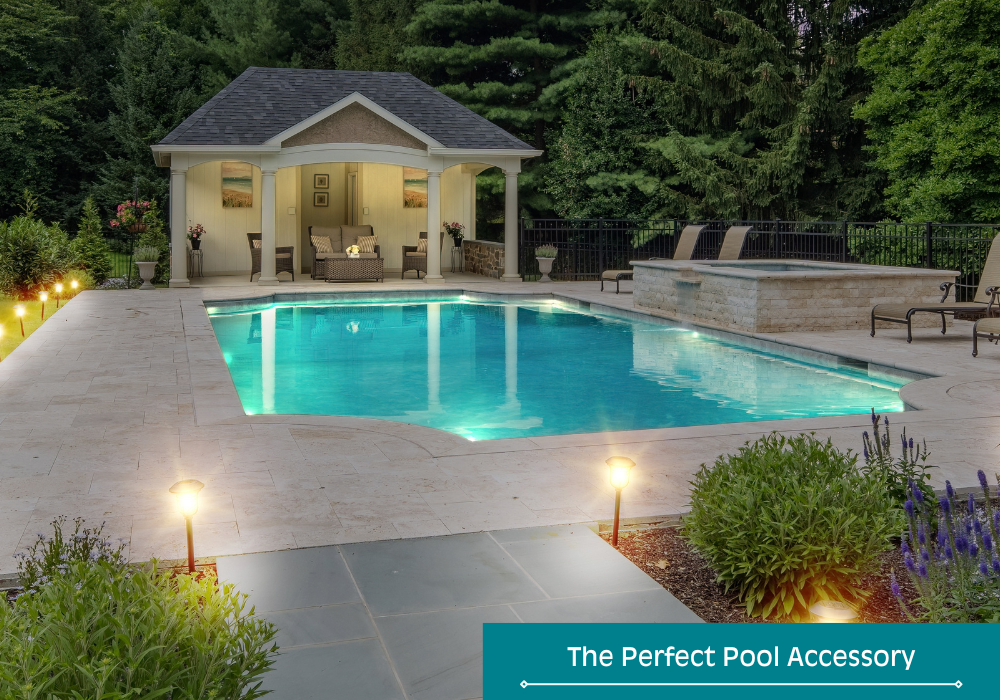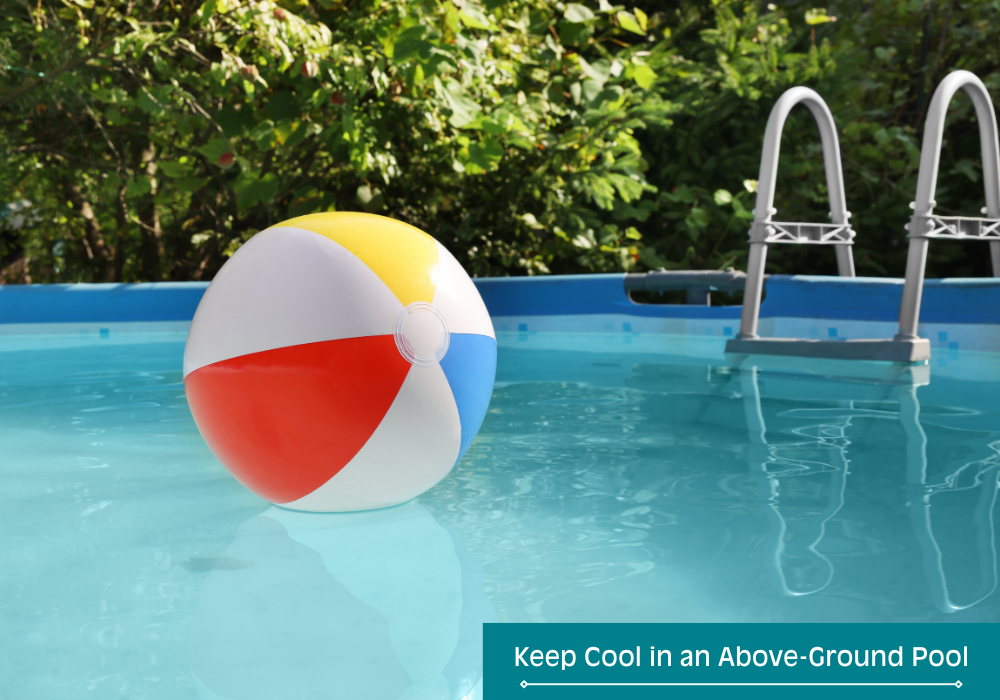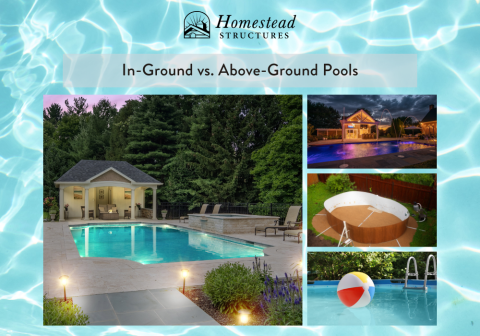There are few things better on a hot day than sliding into a backyard pool. A home pool is convenient and private. You never have to drive to a public space and share the water with other families that also want to cool off.
If you’re considering adding a pool to your home, use this guide to decide whether an above- or in-ground pool is right for you.
In-Ground Pools
In-ground pools sit flush against your lawn, which means they don’t stick up above the grass line. This makes them look like a pond in your backyard.
In-ground pools come in a variety of shapes. Some homeowners want rectangular pools so they can swim laps, while others want ovular or bean-shaped pools with unique curves.
In-ground pools often increase home resell value more than above-ground options. Home appraisers don’t include above-ground pools in the estimate of the home because owners can take the pool with them.
How Are In-Ground Pools Made?
In-ground pools are made by excavating dirt from your yard, lining the hole with your waterproof material of choice, and then filling the hole with water. Most in-ground pools have extra features that require more installation steps, such as lighting features or a filtration system to keep the water clean.
Here are just a few materials and machines needed to build an in-ground pool:
-
Heavy-duty digging equipment
-
Steel supports
-
Pool material — usually concrete or fiberglass
-
Filtration system
-
Lighting elements if desired
-
Hose to add water
-
General construction tools
-
A dumpster or plan to remove dirt and waste
You’ll most likely need to hire a professional to install the pool. These experts work faster and have access to the right tools and materials.
Where To Build In-Ground Pools
Residential in-ground pools are usually built in backyards. Two key factors that determine pool viability are the level of the ground and the soil. Certain soil types, — like sand and clay — may be harder to work with and may require more time and certain support structures.
Your pool contractor can give you advice on where to install your in-ground pool. They’ll usually recommend an area close enough to the house to access it easily but far enough away to prevent accidental falls into the water.
How Much Does It Cost To Build an In-Ground Pool?
On average, an in-ground pool costs around $55,000 to build. This depends on where you’re building the pool and its size. Some people pay less than $39,000 for their pools on the low end, while other homeowners pay more than $70,000 for pool installation on the high end.
 Installation is usually only one cost involved. Other accessories and elements such as a deck will increase the cost of this project. Luckily, adding a pool house to your backyard to complement the pool won’t drown your budget, as there are financing options available.
Installation is usually only one cost involved. Other accessories and elements such as a deck will increase the cost of this project. Luckily, adding a pool house to your backyard to complement the pool won’t drown your budget, as there are financing options available.
How To Maintain an In-Ground Pool
A well-maintained in-ground pool can last between 20 to 35 years with high-quality materials and installation. This means your swimming pool is an investment that can last for decades with the right care and maintenance.
You need to frequently clean your pool, keep the chemicals balanced, and maintain your filter throughout the year. In cold areas, some homeowners seal off their pools during the fall and winter months to protect them.
Safety Considerations for Having an In-Ground Pool
If you’re investing in an in-ground pool, spend some time learning about pool safety for your kids and pets. Here are a few safety elements to consider.
-
When thunder roars, stay indoors: If you hear thunder in your area or see a storm coming in, leave the pool area.
-
Get CPR certified: This will come in handy in case someone is drowning. Some communities offer pool first-aid courses for parents.
-
Know your fencing laws: Some states require fences around pools to prevent accidental drownings. Even if you don’t install a fence, use protective pool coverings that can prevent drownings.
-
Keep backyard accessibility in mind: Make sure your pool area is safe for people to walk around and easy to access.
-
Always watch your kids and pets when they use the pool: Never let your kids swim unsupervised and learn the symptoms of “secondary drowning” which can occur even when kids are seemingly safe.
Be sure to share this information with your family. Explain to your kids why it is important to follow pool safety best practices so they don’t hurt themselves.
Pros of In-Ground Pools
There are several benefits of installing an in-ground pool for your home. Here are a few reasons why you will love yours.
-
They last longer than above-ground models.
-
They can increase your home’s resale value — especially in hot areas.
-
You can create a resort-style experience around the pool with lounge chairs and a tiki bar.
-
You no longer need to visit public pools or pay for a gym membership to swim.
Cons of In-Ground Pools
While valuable, there are some drawbacks to adding an in-ground pool to your home. Here are a few reasons why these pools aren’t right for everyone.
-
They are significantly more expensive than most above-ground pools.
-
You need to clean the pool frequently and keep the chemicals balanced.
-
They might not increase your resale value as much as you want.
-
In cold areas, you might only be able to swim in the pool for a few months out of the year.
Above-Ground Pools
As opposed to in-ground pools, you don’t need to dig into the ground for an above-ground pool. They can rest on top of your grass or in a designated area. These pools are usually smaller than in-ground pools and come in round or ovular shapes.
Out of 130 million households in the United States, around eight percent have swimming pools. Around 41% of those pools are above ground — 4.3 million above-ground pools in total.
How Are Above-Ground Pools Made?
Above-ground pools are easier to install because you can place them almost anywhere in your backyard. Many people can install above-ground pools by themselves — especially if they are considering smaller models. Along with setting up the pool and adding water, homeowners also need to prepare the ground to make sure it is stable enough before the pool is ready to be installed.
Here are a few materials needed to build an above-ground pool:
-
Either a shovel to flatten the ground where your pool will be or concrete to create a slab for it.
-
A toolbox with screwdrivers, wrenches, and other items you might need.
-
A hose or water source.
The tools you need will depend on the above-ground pool you buy. Some are more complex than others.
Where To Build Above-Ground Pools
An above-ground pool can be placed almost anywhere in your backyard. However, you might want to consider what would happen if the pool broke. You don’t want all of the water to flow toward your house. Consider installing your pool on a flat area where the water would spread out evenly or on a hill where the water would flow away from your home.
How Much Does It Cost To Build an Above-Ground Pool?
Above-ground pools are usually more affordable. The average above-ground pool cost is around $2,800. Some people spend less than $1,000 to buy and install these pools.
Like in-ground pools, different features will drive up your total costs. For example, if you want to install a pergola or gazebo next to your pool to create shade, your overall project costs will increase.
How To Maintain an Above-Ground Pool
Above-ground pools usually only last between seven and 15 years, even if they are well-maintained. Regardless of the type of pool you have, maintenance is key for getting the most out of this investment.
Make sure you regularly clean your above-ground pool and check the chemical balance at least weekly. You can also buy a lid for your pool and seal it off during the winter months.
Safety Considerations for Having an Above-Ground Pool
 It is important to follow the same safety tips with an above-ground pool as an in-ground model. Make sure your kids stay out of the pool when there is thunder around and never let them swim unattended. However, there are a few specific safety concerns with above-ground pools.
It is important to follow the same safety tips with an above-ground pool as an in-ground model. Make sure your kids stay out of the pool when there is thunder around and never let them swim unattended. However, there are a few specific safety concerns with above-ground pools.
-
Enforce a no-diving policy. Above-ground pools are too shallow for jumping or diving.
-
Make sure everyone can safely climb in and out. Install stairs or an accessible ladder to leave the pool safely.
-
Set capacity limits. Smaller pools can become unsafe with too many people.
Make sure everyone agrees to these rules before entering the pool.
Pros of Above-Ground Pools
There are multiple reasons to add one of these pools to your home. Here are a few perks of above-ground pools.
-
They are much more affordable so you can pay off your investment faster.
-
It is easier to install so you can use it sooner.
-
You can bring the pool with you when you move.
-
They are usually smaller so they use less water.
Cons of Above-Ground Pools
These pools aren’t for everyone. Consider a few drawbacks of above-ground models.
-
They do not add to your resale value because the owner can move with the pool.
-
It might not be worth the cost if you don’t swim in the pool frequently.
-
This option could be too small for your family and friends.
-
They are less stable than in-ground pools.
Consider your budget, house goals, and pool viability to decide whether an in-ground or above-ground pool is best for you.

Facebook Comments Box